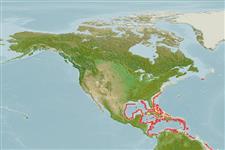Actinopterygii (ray-finned fishes) >
Anguilliformes (Eels and morays) >
Nettastomatidae (Duckbill eels)
Etymology: Nettenchelys: Greek, netta = duck + Greek, enchelys, -yos = eel (Ref. 45335); exoria: From the Greek exorios meaning beyond the frontier, in reference to the posterior nostrils, which have migrated beyond the occiput and are located behind the head (Ref. 40819).
Environment / Climate / Range
Ecology
Marine; bathydemersal; depth range 277 - 494 m (Ref. 40819). Deep-water, preferred ?
Western Central Atlantic: off the northeast coast of Florida and from the junction of the Northwest and Northeast Providence Channels in the Bahamas.
Size / Weight / Age
Maturity: Lm ? range ? - ? cm
Max length : 46.7 cm TL male/unsexed; (Ref. 40819)
Short description
Morphology | Morphometrics
Posterior nostril behind occiput, between supratemporal canal and dorsal-fin origin. Median supratemporal pore absent, apparently obliterated by nasal tube. Anterior vomerine teeth not enlarged. Predorsal 32-34% preanal, head 31-34% preanal.
Life cycle and mating behavior
Maturity | Reproduction | Spawning | Eggs | Fecundity | Larvae
Smith, D.G., J.E. Böhlke and P.H.J. Castle, 1981. A revision of the nettastomatid eel genera Nettastoma and Nettenchelys (Pisces: Anguilliformes), with descriptions of six new species. Proc. Biol. Soc. Wash. 94(2):535-560. (Ref. 40819)
IUCN Red List Status (Ref. 115185)
CITES (Ref. 94142)
Not Evaluated
Threat to humans
Harmless
Human uses
More information
Common namesSynonymsMetabolismPredatorsEcotoxicologyReproductionMaturitySpawningFecundityEggsEgg development
Age/SizeGrowthLength-weightLength-lengthLength-frequenciesMorphometricsMorphologyLarvaeLarval dynamicsRecruitmentAbundance
ReferencesAquacultureAquaculture profileStrainsGeneticsAllele frequenciesHeritabilityDiseasesProcessingMass conversion
Tools
Special reports
Download XML
Internet sources
